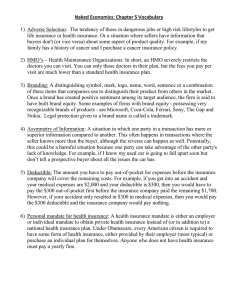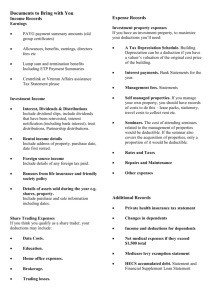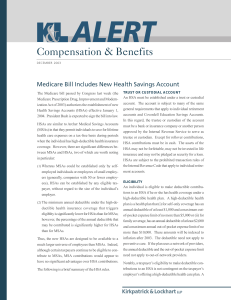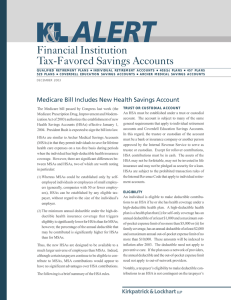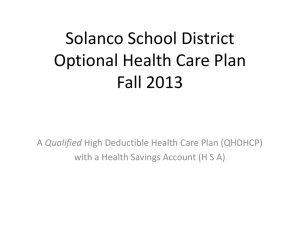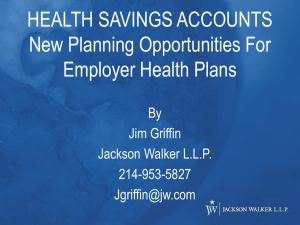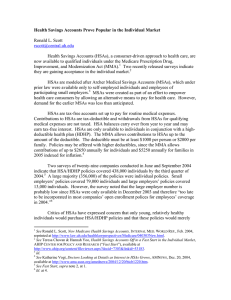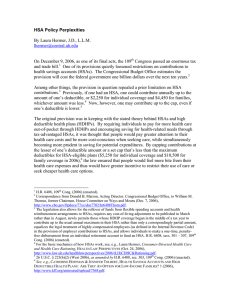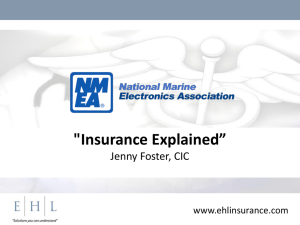Ways to pay with your Blackhawk HSA
advertisement
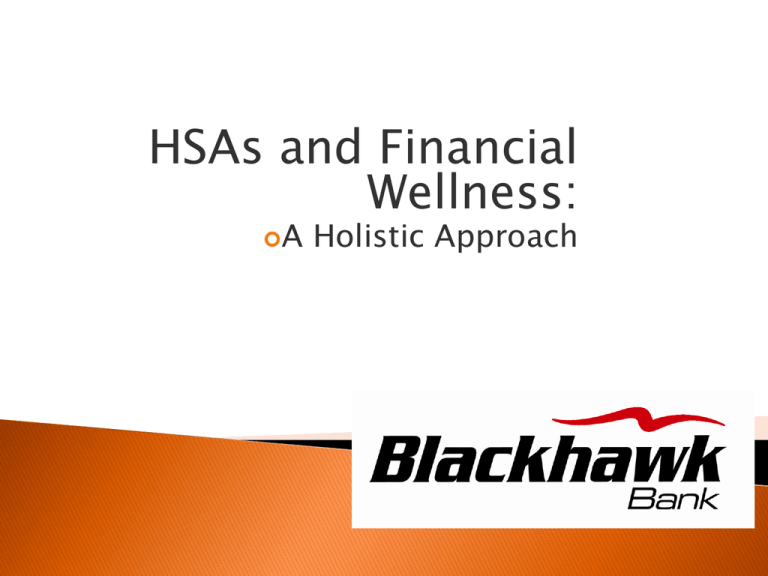
HSAs and Financial Wellness: A Holistic Approach A short review of HSAs – some basic, some new Context and connection: your physical and financial health We view financial education as a stress reduction tool We provide personal service, delivered by subject matter experts – our Bank Mission: To Add Value 130 year-old locally owned (Rock River Valley) independent, mid-sized bank “Five Star” rating from Bauer Financial and “Outstanding” by the FDIC We custodian 5,000+ HSAs nationally, working with over 350 employer groups as well as individual clients We not only custodian HSAs, we’ve owned them too-since January, 2005 We understand the “end-user perspective” Like you, we view our roles as guides for our clients; because of this members of our HSA team are Life and Health licensed through Wisconsin OCI We’ve been through the conversion-to-aCDHP firsthand. Here’s what we learned… Blackhawk Bank Understanding how the HSA works (the mechanics) is important for everyone involved in the process - client, agent, accountant Education is the key to successful implementation and to seeing the value of a Consumer Driven Health Plan and an HSA CDHPs can be a good fit for any industry, and any size group. What Exactly Is A Health Savings Account? A tax preferred bank account (usually checking) – this means that you put money in tax free if through payroll deduction. Post tax contributions can come from any number of sources, and are tax deductible when the individual files (always federal; most states – now finally in Wisconsin) A client earns interest tax free Monies spent or “distributed” stay tax free as long as they are used for medical expenses (RXs, dental, vision, deductibles) for you OR your dependents. Note: These folks don’t have to be covered by your insurance A Savings account is NOT transactional Conversely, a Checking account is designed specifically for transactions - paying bills, or buying goods and services Savings and Checking accounts are governed by different rules They are coded differently “behind the scenes” at the bank HSAs are Checking accounts that have specific codes related to taxation, producing different end-of year documents for reporting purposes Currently enrolled in a CDHP (HDHP) Not enrolled in and using Medicare** Not claimed as a dependent on someone else’s taxes Not covered by other medical insurance (exceptions are workers’ comp., separate dental, vision, etc.) **Please consult www.ustreas.gov for further details For Individuals, the opportunity is $3,250 For Families, the opportunity is $6,400 Catch up is $1,000 per eligible individual* *Spouses must have a separate account, but once established funds cannot co-mingle; a spouse does not have to be on your plan to make this contribution but does need to have Qualified High Deductible coverage of their own (independently or through their employer) Deductible Minimums for 2013: individual deductible must be $1250, and family must be $2500 (each can be higher, but this is the minimum) Maximum total out of pocket limits for 2013: are $6,250 for an individual and $12,500 for a family Discount plans for drugs are fine, (like Walgreens or CVS offers) and they work in tandem with any plan No co-pay structure allowed for routine care and for drugs (full cost out of pocket, less the network discount) Drug costs (regardless of how they are paid, or which drugs are purchased) go toward satisfying the deductible Money can be contributed pre-tax through payroll, in addition to employer contributions Balances accumulate tax free interest Dollars stay tax free if spent on qualified medical expenses (dental and vision too) Post-tax deposits (deposits not made through payroll) are tax deductible Contributions can be posted up until April 15 for previous-year’s deductibility WI is finally State tax deductible! Payroll deductions CAN BE CHANGED NO USE IT OR LOSE IT A debit card (remember the vast majority of HSAs are actually checking accounts) The ability to order checks from the bank of choice, or from other sources ATM access (standard with most debit cards) Possibly – online banking Possibly – online bill pay Have an upfront fee to open for the individual Have a monthly fee charged from day one Be charged for “per-transaction use” Charge for statements or online functions Be a program that burdens employers with layers of new administrative problems Become a new headache for the Office Manager , HR professional, or company owner Preventative Wellness + Financial Education = A goal of less stress-related illnesses Money and related issues rank in the top three for stress inducing topics between married people Understanding your physical numbers (BMI, cholesterol, blood pressure) is a great “first step” Feeling confident about your finances and understanding how they work is an essential part of “knowing your numbers” Suggest changes a person can make to their diet Discuss fitness options and coach toward increased and varied activities Help a person understand that they will decrease the likelihood of chronic illness through a lifestyle change Offer tools for tracking progress Wellness programs typically do a fairly good, if indirect, job of addressing different stress related issues Most programs include exercise elements with varying difficulty – the goal being to at least get folks moving if not in peak physical condition Movement = Endorphins = Stress reduction Lifestyle Changes beyond the Physical Knowing your “numbers” is important to your financial (as well as physical) health Just as blood pressure and cholesterol scores effect your physical life, your credit score effects your financial one Your credit score should be considered a “vital statistic” and maintenance is a must Unfortunately many people would rather guess than know, much like other vital statistics… Credit Score – what it is; how it effects day-to day expenses; how to change it Budgeting – A tool that’s easy to use Balancing – Knowing what you have! Folks who have no idea how to read a credit report (hint – that’s a lot of us!) Folks who have never seen their credit report or who haven’t looked at it in the last year Those who can estimate what they think their score should be… Those who “know their credit should be better than that” once they do see their score “Financial Fitness” workshops that are done a la carte, chosen by an employer after an employee survey All information is confidential There is no obligation for the employees to bank with us before or after Our goal is to be “of service” to the communities we call home, and To Add Value How to read and understand your credit report MEMBER FDIC FICO scores have a 300-850 point range Blackhawk Bank Realize Your Dreams by Living on a Budget MEMBER FDIC Housing 25% Transportation 15% Food 15% Other Expenses* 15% Entertainment 10% Savings 10% Clothing 5% Charitable Giving 5% *Other expenses can include utilities (Electricity, gas, phone cable/satellite TV, Internet access), medical expenses and insurance. Blackhawk Bank Means different things for different clients One size does not fit all Like you: We listen, then we tailor the program to fit the clients needs We serve local and distance clients We would love to become the “HSA and Financial Education go-to” for your team!

